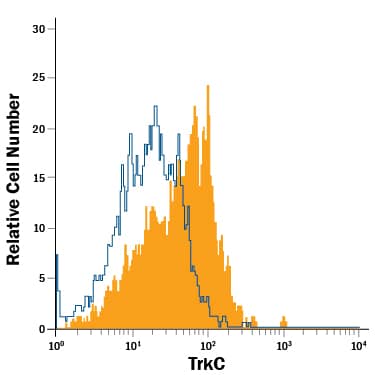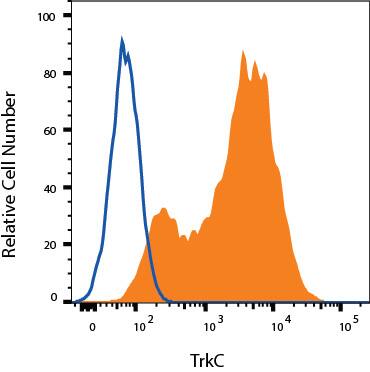Human TrkC PE-conjugated Antibody
R&D Systems, part of Bio-Techne | Catalog # FAB373P


Key Product Details
Species Reactivity
Validated:
Human
Cited:
Human
Applications
Validated:
Flow Cytometry
Cited:
Flow Cytometry
Label
Phycoerythrin (Excitation = 488 nm, Emission = 565-605 nm)
Antibody Source
Polyclonal Goat IgG
Product Specifications
Immunogen
Mouse myeloma cell line NS0-derived recombinant human TrkC
Cys32-Asp428
Accession # Q16288
Cys32-Asp428
Accession # Q16288
Specificity
Detects human TrkC in direct ELISAs and Western blots. In direct ELISAs and Western blots, less than 1% cross-reactivity with recombinant human TrkB is observed.
Clonality
Polyclonal
Host
Goat
Isotype
IgG
Scientific Data Images for Human TrkC PE-conjugated Antibody
Detection of TrkC in Differentiated Human Neural Progenitor Cells by Flow Cytometry.
Differentiated human neural progenitor cells were stained with Goat Anti-Human TrkC PE-conjugated Antigen Affinity-purified Polyclonal Antibody (Catalog # FAB373P, filled histogram) or isotype control antibody (IC108P, open histogram). View our protocol for Staining Membrane-associated Proteins.Detection of TrkC in A549 cells by Flow Cytometry
A549 cells were stained with Goat Anti-Human TrkC PE-conjugated Antigen Affinity-purified Polyclonal Antibody (Catalog # FAB373P, filled histogram) or isotype control antibody (Catalog # IC108P, open histogram). View our protocol for Staining Membrane-associated Proteins.Applications for Human TrkC PE-conjugated Antibody
Application
Recommended Usage
Flow Cytometry
10 µL/106 cells
Sample: Differentiated human neural progenitor cells; A549 human lung carcinoma cell line
Sample: Differentiated human neural progenitor cells; A549 human lung carcinoma cell line
Formulation, Preparation, and Storage
Purification
Antigen Affinity-purified
Formulation
Supplied in a saline solution containing BSA and Sodium Azide.
Shipping
The product is shipped with polar packs. Upon receipt, store it immediately at the temperature recommended below.
Stability & Storage
Store the unopened product at 2 - 8° C. Do not use past expiration date. Protect from light.
Background: TrkC
Long Name
Neurotrophic Tyrosine Kinase Receptor C
Alternate Names
NTRK3
Gene Symbol
NTRK3
UniProt
Additional TrkC Products
Product Documents for Human TrkC PE-conjugated Antibody
Product Specific Notices for Human TrkC PE-conjugated Antibody
For research use only
